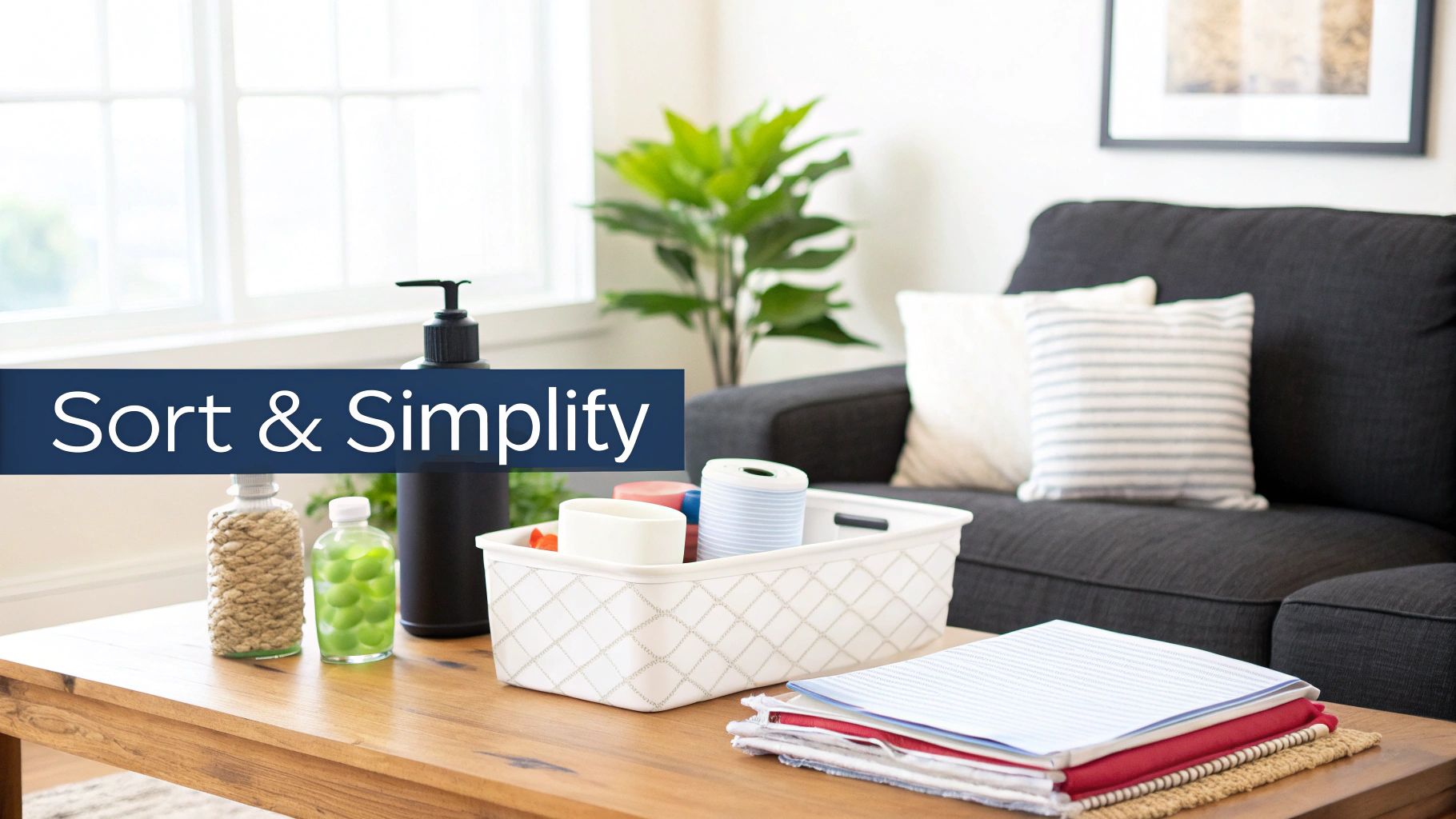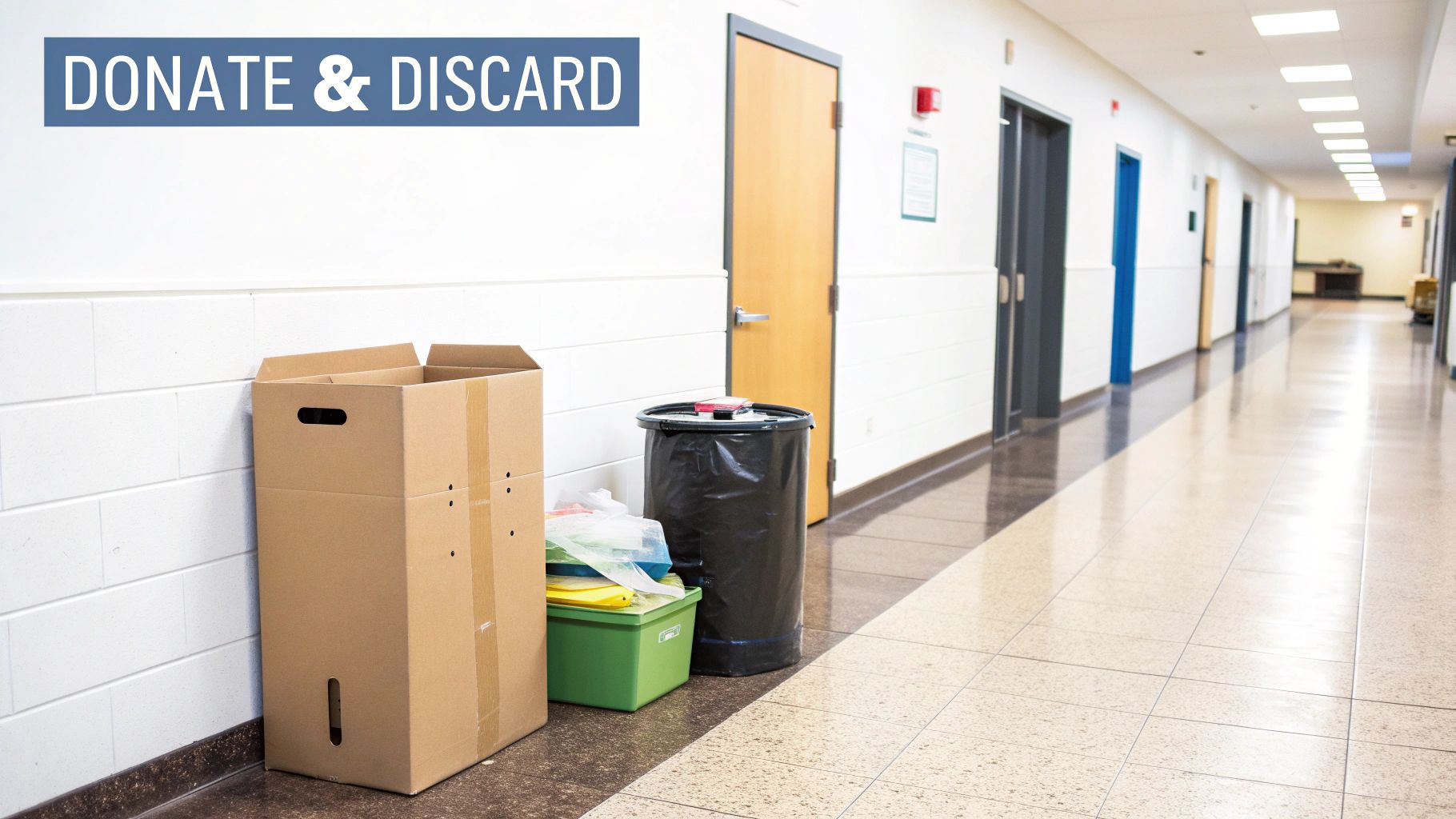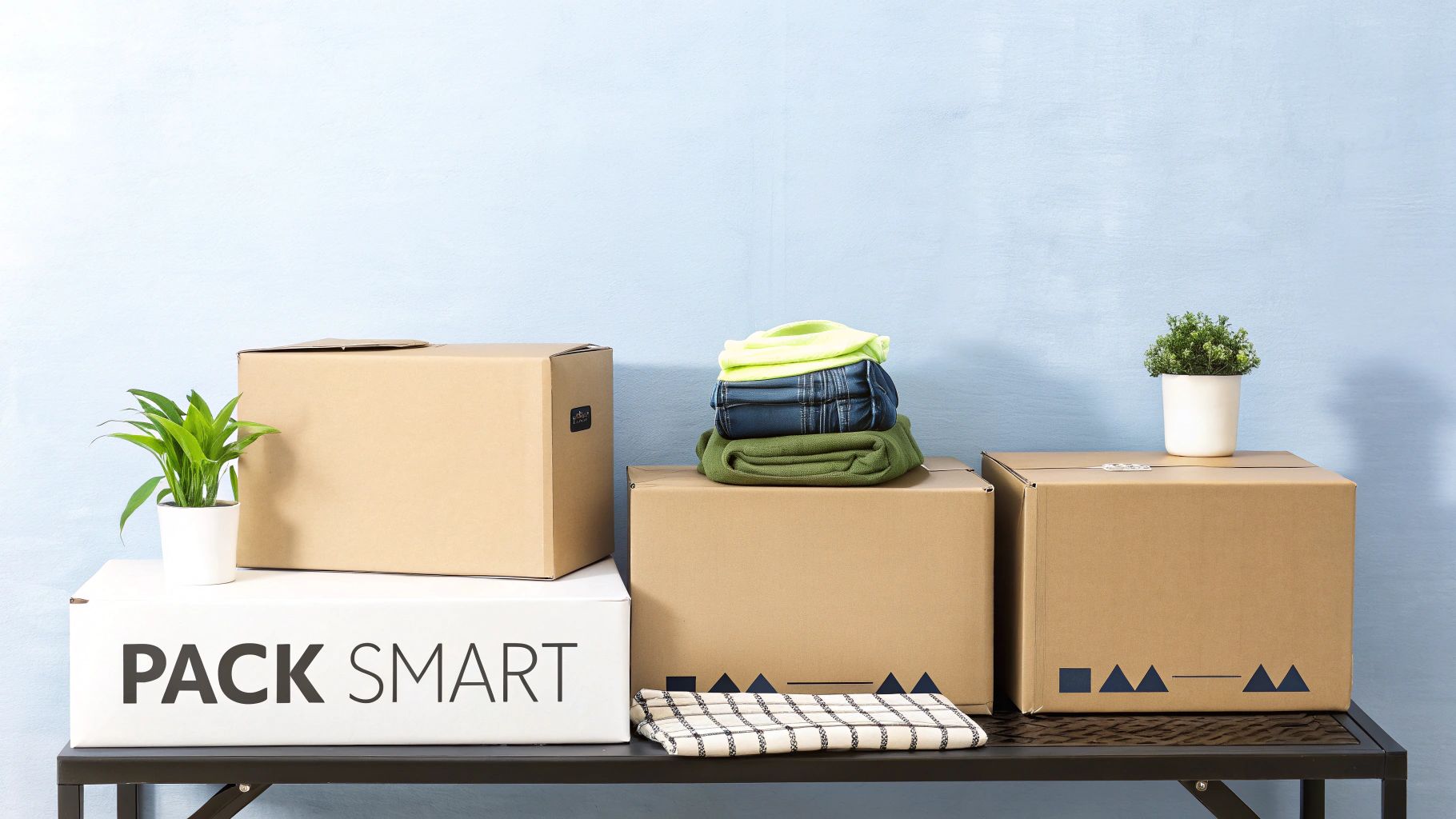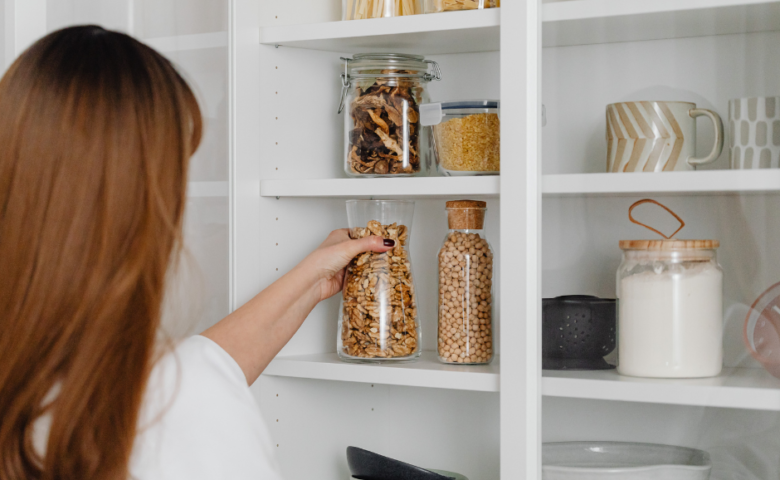Why Decluttering Before Moving Actually Matters

Moving can feel overwhelming, especially when you’ve accumulated years of belongings. But decluttering beforehand can truly change the experience. It’s not just about less packing; it’s about making the whole transition smoother, more efficient, and even emotionally rewarding.
The Financial and Logistical Perks of Decluttering
One of the biggest benefits of decluttering is saving money. Think of your belongings as items on a moving truck. Each one adds weight, increasing the final cost. Decluttering is a crucial step to save both time and money.
Professional organizer Jennifer Dwight points out that movers charge by weight. So, getting rid of things not only saves you the trouble of packing and unpacking them, it also lowers your moving bill. Fewer items equal less weight, and that translates directly to cost savings. For more details and statistics on decluttering to save, check out this helpful resource: Learn more about decluttering to save money
Decluttering also simplifies the entire moving process. Less to pack means less packing material to buy, fewer boxes to label, and a much faster packing process. This efficiency carries over to unpacking, too. Imagine arriving at your new home and only unpacking essentials, instead of sorting through boxes of things you no longer need.
Decluttering for a Fresh Start
Beyond the practical advantages, decluttering offers a significant psychological benefit: a fresh start. Moving often represents a new chapter in life. Decluttering helps you shed the past, both literally and figuratively, creating space for new experiences.
This pre-move purge can be empowering. You consciously choose what to bring into your next chapter. It’s a chance to decide what’s truly important and create a home filled with intention and meaning.
Breaking Emotional Attachments
One of the hardest parts of decluttering is letting go of emotional attachments. We connect items with memories, people, and past versions of ourselves. This can make sorting through belongings feel difficult.
Remember, letting go of a physical item doesn’t mean losing the memory associated with it. The key is to curate what you keep. Keep the items that truly resonate with who you are now, while letting go of those that no longer serve you. This helps you create a new space that reflects your current self and future aspirations. This mindful process transforms your move into a journey of self-discovery.
By decluttering strategically before you move, you’re not just making the process easier. You’re creating a smoother, more affordable, and more fulfilling transition to your new home. It’s an investment in your present and future happiness.
The Perfect Decluttering Timeline: When to Start

Decluttering before a move isn’t just a good idea; it’s essential for a smoother, less stressful, and more budget-friendly relocation. Knowing when to begin is crucial. Proper timing can transform this potentially overwhelming task into a manageable project.
Why a Phased Approach Is Key
Professional organizers recommend a phased approach to decluttering. This prevents feeling overwhelmed and allows for a more systematic process. Don’t try to tackle your entire house at once. Instead, break the process down into smaller, manageable steps.
This might involve focusing on a single room, or even a specific area within a room, like a closet or drawers. This phased approach builds momentum and creates a sense of accomplishment as you progress.
The Ideal Decluttering Schedule
Your ideal decluttering timeline depends on your specific situation. With several months before your move, you can dedicate a few hours each week to sorting and purging. But even with less time, a strategic approach is still important.
Starting early is key, as decluttering can take several weeks. This allows time to methodically decide what to keep and discard. This is especially challenging for older adults who may have accumulated many belongings over the years. Learn more about decluttering for seniors.
Prioritizing High-Impact Areas
Focus on high-impact areas first. These are the areas that will save you the most time and money during the move, or those prone to clutter. Kitchens, for example, often contain duplicate gadgets and rarely used appliances.
Closets are another area ripe for decluttering, often filled with unworn clothes. Focusing on these areas initially gives you a sense of progress, boosting motivation.
Managing Decision Fatigue
Decluttering involves constant decision-making, leading to decision fatigue. Combat this by setting clear criteria for what stays and what goes. Consider usefulness, sentimental value, and whether the item fits your new lifestyle.
Having these guidelines streamlines decisions and prevents overwhelm. Schedule regular breaks to avoid mental exhaustion. Short breaks improve focus and prevent hasty decisions. Remember, decluttering is a marathon, not a sprint.
To help visualize your decluttering journey, take a look at this helpful timeline:
This table provides a week-by-week breakdown of decluttering tasks, tailored to your moving timeline. It offers a structured approach, making the process less daunting and more efficient.
| Weeks Before Moving | Areas to Declutter | Tasks to Complete |
|---|---|---|
| 8 Weeks | Garage, Attic, Basement | Sort through stored items, donate or discard unwanted items, organize remaining belongings. |
| 6 Weeks | Guest Room, Storage Closets | Declutter and organize seldom-used items, donate or discard unwanted belongings. |
| 4 Weeks | Kitchen | Clear out pantry, cupboards, and drawers. Discard expired food, donate or discard unused appliances and gadgets. |
| 2 Weeks | Bedrooms, Closets | Sort through clothing, shoes, and accessories. Donate or discard unwanted items, pack seasonal items. |
| 1 Week | Bathrooms, Linen Closets | Discard expired toiletries and medications, declutter linens and towels. |
This timeline allows you to tackle different areas of your home systematically, leading up to your move. Focusing on specific zones each week makes the task less overwhelming and more manageable. Remember to adjust this schedule based on your own moving timeline and the size of your home.
Room-by-Room Decluttering: Where Success Happens

Decluttering before a move can feel overwhelming. A room-by-room approach makes the process much more manageable. By breaking down the task into smaller chunks, you can focus your energy and make real progress, which is key to staying motivated.
Starting Strong: Identifying Your First Targets
Begin with less-used rooms like guest rooms or storage areas. These spaces are often full of forgotten items and offer a great starting point to gain momentum. An early win builds confidence for tackling more cluttered areas later.
For example, start by decluttering the guest room closet or under the bed. This allows you to get started without the stress of tackling major living areas right away.
Consider prioritizing high-traffic areas like kitchens early on. Kitchens are known for accumulating unused gadgets and appliances. Decluttering this space early can save you significant time and money during the move. Fewer items to pack means less to unpack, making the whole process more efficient.
Tackling Sentimental Spaces: The Bedroom and Beyond
Bedrooms, often filled with sentimental items, need a gentler approach. Start with easy-to-declutter items like clothing and accessories. This builds momentum before tackling more emotionally challenging possessions. Sorting through socks and getting rid of worn-out pairs can be a good first step.
Next, move on to sentimental items. Remember, decluttering doesn’t mean discarding memories. Digitizing photos and keepsakes saves space while preserving those precious moments. You get to keep the memory without the physical clutter.
Organizing Chaos: The Garage and Storage Areas
Garages and storage areas are often the most challenging. Use a practical system with clear bins and labels. This makes sorting and packing easier. For example, designate bins for sports equipment, holiday decorations, or tools.
Think about functionality. If something hasn’t been used in a year, it’s probably not needed and can be removed. This prevents moving unnecessary items to your new home.
The Four-Box Method: A Proven Decluttering Strategy
Many professional organizers suggest the four-box method: Keep, Donate, Sell, and Trash. This system makes decisions easier and streamlines the process, helping you avoid decision fatigue.
- Keep: Items you need and use in your new home.
- Donate: Items in good condition that someone else could use.
- Sell: Items you could sell to recoup some moving costs.
- Trash: Items that are broken or unusable.
This method helps you stay focused when your motivation starts to drop. It provides a clear path for each item and prevents things from just being shuffled around. Consistently using this method ensures you can efficiently declutter every room and transition smoothly to your new home.
The Hidden Impact: Decluttering for Environmental Good

Decluttering before a move offers many personal advantages. It can lead to a less stressful moving day and a fresh start in your new place. But decluttering also presents a valuable opportunity: the chance to make environmentally sound choices.
Think about the impact of your discarded belongings and strive for sustainable disposal methods. This mindful approach not only minimizes your environmental footprint but also helps create a healthier planet.
Why Responsible Decluttering Matters
Our consumption habits significantly impact the environment. Thoughtful decluttering can help lessen these effects. Simply throwing everything in the trash adds to overflowing landfills.
Unwanted furniture, for instance, frequently ends up in landfills. This takes up precious space and can release harmful chemicals as it decomposes. The effect of clutter on our personal well-being and the environment is substantial.
Over 54% of Americans feel overwhelmed by the clutter in their homes. Around 80% struggle with stress and anxiety related to cluttered living spaces. Find more detailed statistics here. This highlights the importance of mindful decluttering for both ourselves and the planet. This often inspires people to adopt more sustainable practices in other areas of their lives.
Sustainable Disposal Practices
Responsible decluttering involves making conscious decisions about unwanted items. It’s about more than just tossing things away. Consider donating usable goods to charities or selling them through online marketplaces like eBay or consignment shops.
This keeps items out of landfills and benefits others. For example, donating clothes to a local shelter helps those in need and reduces textile waste. Items requiring special disposal, such as electronics and hazardous materials, should be handled responsibly according to local guidelines. This protects the environment from harmful pollutants.
Redistributing Your Goods: A Win-Win
Thoughtfully redistributing your belongings extends the lifespan of your items and benefits your community. It’s like giving your possessions a second life instead of adding to the waste stream.
Donating gently used furniture to a local charity provides someone with essential household items and keeps furniture out of landfills. This thoughtful approach supports a circular economy, where goods are reused and repurposed rather than discarded.
Finding the Balance: Convenience and Conscience
Decluttering before a move is often driven by the desire for convenience. However, it can also be a chance to adopt more sustainable practices. Smart movers find a balance between efficiency and environmental responsibility.
They recognize the value in donating, recycling, or responsibly disposing of items. This mindful approach can create lasting positive change. It fosters a mindset of conscious consumption and waste reduction that goes beyond the move itself, setting the stage for a more sustainable lifestyle in their new home.
Navigating the Emotions of Letting Go
Decluttering before a move isn’t just about sorting through your belongings. It’s an emotional journey that requires careful thought and planning. Letting go of items, especially those with sentimental value, can be tough, but it’s a crucial step for a smoother transition.
Understanding the Emotional Connection to Possessions
We often develop deep attachments to our things. They can represent cherished memories, important relationships, and significant life events. This emotional connection can make decluttering difficult because parting with these items can feel like a real loss.
For example, a beloved childhood toy might bring back happy memories, while a piece of furniture could remind you of a loved one. These attachments are completely normal. However, it’s important to address them directly to make the decluttering process easier.
Techniques for Handling Grief-Attached Items
When dealing with items that have strong emotional ties, it’s essential to acknowledge the feelings they evoke. Allow yourself to feel the sadness, nostalgia, or even guilt. This acknowledgement can help you decide what to keep and what to let go.
Consider taking photos of sentimental items before donating or discarding them. This allows you to preserve the memory without holding onto the physical item. Repurposing sentimental items is another great option. For example, you could transform a loved one’s clothing into a quilt or a memory pillow.
Preserving Memories Without Keeping Everything
One of the biggest myths about decluttering before a move is that you must get rid of all sentimental items. This isn’t true. The goal is to be mindful about what you keep, making sure each item holds real meaning and serves a purpose in your new home.
Think about what genuinely brings you joy and reflects who you are now. This shifts the focus from loss to curating a collection of items that enrich your life moving forward. External factors can also influence decluttering decisions. As awareness of consumerism and waste management grows, so does the importance of decluttering. Sometimes, a major life change like an international move can be the catalyst for adopting a more minimalist lifestyle. One person, after multiple moves including two international ones, discovered the value of living with less. Explore this topic further
Involving Family in Sensitive Decisions
Decluttering before a move can be a family affair, especially when sorting through shared possessions. Open communication is essential. Discuss what each person wants to keep and the reasons behind their choices. This ensures everyone feels heard and respected.
Involve family members in sensitive decisions. Explain why you’re decluttering and how everyone can contribute. This shared understanding can reduce anxiety and make the process more manageable. It also teaches children valuable lessons about decluttering.
Transforming Decluttering into a Positive Experience
Decluttering before a move can be emotionally challenging. However, it’s also a chance for personal growth and setting intentions. By approaching the process with self-compassion and a clear vision for your new home, you can turn decluttering into a positive experience.
It becomes an opportunity to reflect on the past, embrace the present, and make room for future possibilities. This mindful approach prepares you for a fresh start in your new home, both physically and emotionally.
Beyond the Trash Bin: Where Unwanted Items Should Go
Decluttering before a move isn’t just about filling trash bags. It’s a strategic process of deciding what to keep, donate, sell, or discard. This requires careful planning and consideration of an item’s value, condition, and potential for reuse.
Maximizing Returns: Selling Your Unwanted Treasures
Some decluttered items can bring in extra cash, which can help offset moving expenses. Online marketplaces like eBay and Facebook Marketplace offer large audiences for selling furniture, electronics, clothing, and more.
For larger items, think about using local consignment shops or classified ads. These platforms connect you with local buyers, simplifying the selling and pick-up process. Choosing the right platform depends on the item’s value and how you prefer to sell.
Donating With Purpose: Finding the Right Home for Your Goods
Donating unwanted items is a fantastic way to declutter while giving back to your community. However, different charities accept different types of items. Research local organizations to find which ones align with your donation goals and will accept your specific items.
For instance, some charities specialize in furniture and household goods, while others focus on clothing or books. Some organizations may even offer pick-up services, making the donation process even easier.
Handling Logistics: Efficient Removal of Unwanted Items
Time is valuable during a move. Make the removal process more efficient by grouping similar items together. Gather all donations for a single drop-off or schedule a bulk pick-up. For items going to the landfill, check with your local waste management services for special pick-ups or designated drop-off locations.
To help you decide where your unwanted items should go, take a look at this comparison of disposal options:
Decluttering Disposal Options Comparison: A comparison of different methods for handling unwanted items when decluttering.
| Disposal Method | Best For | Pros | Cons | Environmental Impact |
|---|---|---|---|---|
| Selling | Items of value | Financial return, keeps items out of landfills | Can be time-consuming, requires effort to list and manage sales | Positive, promotes reuse |
| Donating | Usable items | Benefits others, potential tax deduction, reduces landfill waste | Requires research to find appropriate charities, may need to transport items | Positive, supports communities and reduces waste |
| Recycling | Recyclable materials | Environmentally friendly, conserves resources | Requires sorting and cleaning, not all materials are recyclable | Positive, reduces landfill waste and conserves resources |
| Trash | Broken or unusable items | Easy disposal | Adds to landfills | Negative, contributes to environmental pollution |
This table summarizes the pros and cons of each disposal method, helping you make informed decisions about your belongings. Remember, efficient removal keeps your decluttering momentum going!
Balancing Value and Efficiency
Successful movers understand the balance between getting a fair price for items and just getting things done. While maximizing your return is tempting, sometimes the most efficient approach is the best. Donating items lets you clear space quickly and support worthwhile causes. Consider the value of your time and energy when deciding between selling, donating, or discarding.
Ready to improve your home organization and simplify your next move? Explore LAMU’s home organizers and storage solutions, designed for efficient decluttering and a more organized living space. Discover more at LAMU.








Leave a comment